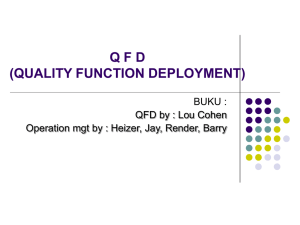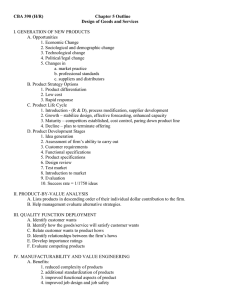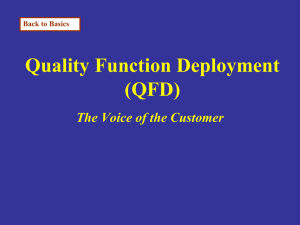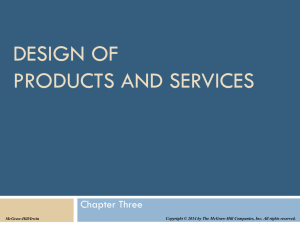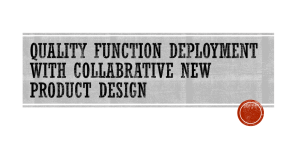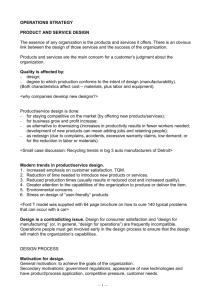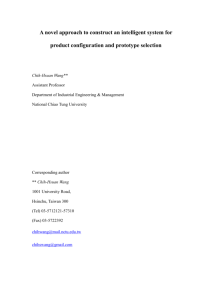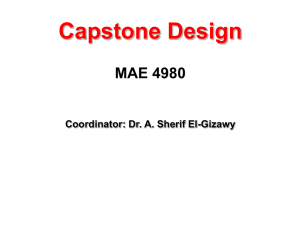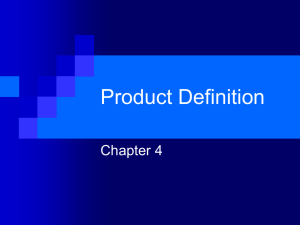IMPROVING PRODUCT DESIGN & PROCESS PLANNING
advertisement
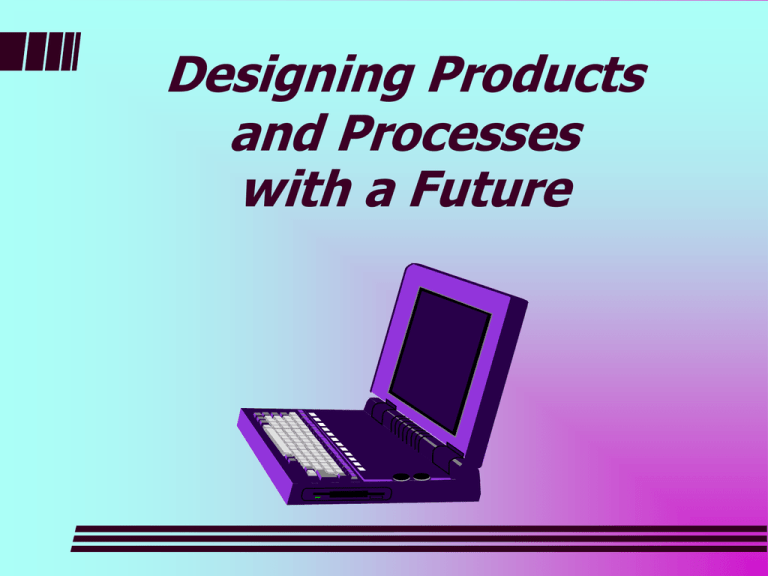
Designing Products and Processes with a Future What does it take? Involve the customer Meet with the customer Listen to customer Educate the customer Incorporate quality function deployment (QFD) Design for robustness What is a customer? The person who buys the product? The federal regulator? The consumer reporter? The marketing and sales department? Engineering? Manufacturing? Suppliers? How do you hear the customer? Features Needs Wants Satisfaction Perception Quality ABOUT Value Importance Competitors Detractors Product Design What the Customer wanted What Marketing described What Engineering designed What Manufacturing buit What is Design? A Decision Making Process – Idea generation Flexibility – Assessment of firm’s ability to carry out – Customer Requirements – Functional Specification – Product Specifications – Concept Generation – Concept Selection – Engineering Design – Engineering Evaluation – Prototype and Testing Manufacturing Design Cost Few Successes Number 2000 1500 1000 Ideas 1750 Market requirement 1000 Design review, Testing, Introduction Functional specifications 500 500 0 Product specification 100 25 Development Stage One success! QUALITY FUNCTION DEPLOYMENT Quality Function Deployment – Uses the voice of the customer to build a design tool: » House of quality QFD: An approach that integrates the “voice of the customer” into the product and service development process. Quality Function Deployment Identify customer wants Identify how the good/service will satisfy customer wants Relate customer wants to product hows Identify relationships between the firm’s hows Develop importance ratings Evaluate competing products House Of Quality Tradeoff Matrix Importance Product characteristics Customer requirements Relationship matrix Technical assessment and target values Competitive assessment House of Quality Example Correlation: X X X * Competitive evaluation Water resistance Accoust. Trans. Window Force needed to open door Force on level ground Door seal resistance Customer Requirements Force needed to close door Engineering Characteristics X X X Strong positive Positive Negative Strong negative X = Us A = Comp. A B = Comp. B (5 is best) 1 2 3 4 Easy to close 7 X Stays open on a hill 5 X AB Easy to open 3 Doesn’t leak in rain 3 No road noise Evaluation 2 AB XAB A XB X A 5 4 3 2 1 B A BA X X An Automotive Door B A X B X A BXA 27 Maintain current level 6 Maintain current level 27 Reduce energy to 7.5 ft/lb. 45 Reduce force to 9 lb. 63 Maintain current level Reduce energy level to 7.5 ft/lb 63 Target values Technical evaluation (5 is best) 5 BA X Relationships: Strong = 9 Medium = 3 Small = 1 B Idea Generation Stage Provides basis for entry into market Sources of ideas – Market need (60-80%); engineering & operations (20%); technology; competitors; inventions; employees Follows from marketing strategy – Identifies, defines, & selects best market opportunities Customer Requirements Stage Identifies & positions key product benefits – Stated in core benefits proposition (CBP) – Example: Long lasting with more power (Sears’ Die Hard Battery) House of Quality Identifies detailed list of product attributes desired Product by customer Characteristics – Focus groups or Customer 1-on-1 interviews Requirements Functional Specification Stage Defines product in terms of how the product would meet desired attributes Identifies product’s engineering characteristics – Example: printer noise (dB) Prioritizes engineering characteristics May rate product compared to competitors’ House of Quality Product Characteristics Customer Requirements Product Specification Stage Determines how product will be made Gives product’s physical specifications – Example: Dimensions, material etc. Defined by engineering House of Quality drawing Done often on computer Component – Computer-Aided Design (CAD) Specifications Product Characteristics Quality Function Deployment Product design process using cross-functional teams – Marketing, engineering, manufacturing Translates customer preferences into specific product characteristics Involves creating 4 tabular ‘Matrices’ or ‘Houses’ – Breakdown product design into increasing levels of detail To Build House of Quality Identify customer wants Identify how the good/service will satisfy customer wants. Relate the customer’s wants to the product’s hows. Develop importance ratings Evaluate competing ideas and concepts Ultimately you choose the design Not the customer! House of Quality Example You’ve been assigned temporarily to a QFD team. The goal of the team is to develop a new camera design. Build a House of Quality. © 1984-1994 T/Maker Co. House of Quality Example What the customer desires (‘wall’) Customer Customer Requirements Importance Light weight Easy to use Reliable Target Values House of Quality Example Average customer importance rating Customer Requirements Light weight Easy to use Reliable Target Values Customer Importance 3 2 1 House of Quality Example Choose engineering characteristics to satisfy the customer requirements Customer Requirements Light weight Easy to use Reliable Target Values Customer Importance 3 2 1 Aluminum Parts Steel Parts Auto Focus Auto Exposure House of Quality Example Relationship between customer attributes & engineering characteristics (‘rooms’) Customer Requirements Light weight Easy to use Reliable Target Values Customer Importance Aluminum Parts Steel Parts 3 2 1 5 2 4 19 8 14 Auto Focus Auto Exposure 8 5 21 7 3 17 QFD Cascades ROBUST DESIGN Design that results in products or services that can function over a broad range of conditions What does Robust Design mean? Plan for variability Assess your capabilities Design for Manufacturing Reduce Costs Practice! Improve RAM-D Variability: The Taguchi Approach to ROBUST DESIGN Design a robust product − Insensitive to environmental factors either in manufacturing or in use. Central feature is Parameter Design Determines − factors that are controllable and those not controllable − their optimal levels relative to major product advances ASSESS CAPABILITIES Identify Core Strengths Match Products To Processing Capabilities – Design for Manufacturing (DFM) DESIGN FOR MANUFACTURING The designers’ consideration of the organization’s manufacturing capabilities when designing a product. Materials Processes Assembly REDUCE COSTS Focus on simplification & standardization − Design for Assembly (DFA) − Increase emphasis on component commonality Study how products are designed & built Eliminate duplicate design & processes Strategically control capital spending INVOLVE OPERATIONS Practice concurrent engineering Establish technical exchange programs Use collaborative styles Look for continual improvement IMPROVE DURABILITY, RELIABILITY, & SAFETY 1) Improve component design 2) Use redundancy 3) Improve production and/or 4) 5) 6) 7) 8) assembly techniques Improve testing Use robust design Use modular design Improve preventive maintenance Educate customers Good Luck with your designs!
